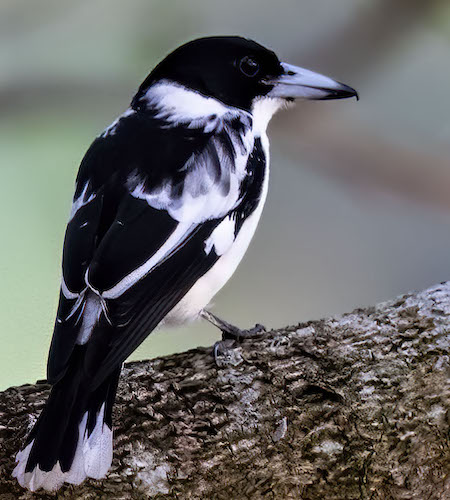Artamidae – Woodswallows, Butcherbirds & Currawongs

Artamidae is a family of passerine birds found in Australia, the Indo-Pacific region, and Southern Asia. It includes 24 extant species in seven genera and two subfamilies: Artaminae (with two genera, the woodswallows & Peltops) and Cracticinae (currawongs, butcherbirds, and the Australian magpie). Artamids used to be monotypic, containing only the woodswallows, but it was expanded to include the family Cracticidae in 1994. Some authors, however, still treat the two as separate families.
Some species, known for their beautiful song, are in this family. Their feeding habits vary from the harmless nector sucking of the woodswallows to the fearless predation on small birds from the pied currawong.
Artamid species occur throughout Australasia with most species occurring in Australia and New Guinea. The social interactions of Artamids vary from the solitary black butcherbird, who lives alone or in a single pair, to the white-breasted woodswallow who lives in flocks or loose colonies. While some species are sedentary, staying close to suburbia and ample food sources, others are migratory or even nomadic like the Masked woodswallow, moving around in response to changes in climate such as rainfall or temperature. Their range of habitats varies between species but most will adapt to rain forests, woodlands, coastal scrubs (swallows), water courses, playing fields, pastoral lands and paperbark mangroves (butcher birds). One of their greatest abilities is to adapt to urban landscapes where they contend with fragmented and degraded remnants of native vegetation.
According to the most recent DNA evidence there are just 24 species in this combined family, which are:
Ashy Woodswallow Artamus fuscus
White-breasted Woodswallow Artamus leucorynchus
Fiji Woodswallow Artamus mentalis
Ivory-backed Woodswallow Artamus monachus
Great Woodswallow Artamus maximus
White-backed [Bismark] Woodswallow Artamus insignis
Masked Woodswallow Artamus personatus
White-browed Woodswallow Artamus superciliosus
Black-faced Woodswallow Artamus cinereus
Dusky Woodswallow Artamus cyanopterus
Little Woodswallow Artamus minor
Lowland Peltops Peltops blainvillii
Mountain Peltops Peltops montanus
Black Butcherbird Melloria quoyi
Australian Magpie Gymnorhina tibicen
Grey Butcherbird Cracticus torquatus
Silver-backed Butcherbird Cracticus argenteus
Black-backed Butcherbird Cracticus mentalis
Pied Butcherbird Cracticus nigrogularis
Hooded Butcherbird Cracticus cassicus
Tagula Butcherbird Cracticus louisiadensis
Pied Currawong Strepera graculina
Black Currawong Strepera fuliginosa
Grey Currawong Strepera versicolor
-
Australian Magpie Gymnorhina tibicen
Species AccountThe Australian Magpie is black and white, but the plumage pattern varies across its range. Its nape, upper tail and shoulder are white in males, grey in females. Across most of Australia, the remainder of the body is black. In the south-east, centre, extreme south-west and Tasmania, the back and rump are entirely white. The eye of adult birds is chestnut brown. -
Australian Magpie Gymnorhina tibicen
Species AccountSound archive and distribution map -
Australian Magpie Gymnorhina tibicen
Species AccountThe Australian magpie (Cracticus tibicen) is a medium-sized black and white passerine bird native to Australia and southern New Guinea. Although once considered to be three separate species, it is now considered to be one, with nine recognised subspecies. -
Black Butcherbird Melloria quoyi
Species AccountThe black butcherbird (Melloria quoyi, also known as Cracticus quoyi) is a species of butcherbird in the family Artamidae. It is found in Australia, Indonesia, and Papua New Guinea. Its natural habitats are subtropical or tropical dry forest, subtropical or tropical moist lowland forest, and subtropical or tropical mangrove forest. -
Dusky Woodswallow Artamus cyanopterus
IUCN Species StatusDespite the fact that the population trend appears to be decreasing, the decline is not believed to be sufficiently rapid to approach the thresholds for Vulnerable under the population trend criterion (>30% decline over ten years or three generations). The population size has not been quantified, but it is not believed to approach the thresholds for Vulnerable under the population size criterion (<10,000 mature individuals with a continuing decline estimated to be >10% in ten years or three generations, or with a specified population structure). For these reasons the species is evaluated as Least Concern. -
Dusky Woodswallow Artamus cyanopterus
Species AccountThe dusky woodswallow (Artamus cyanopterus),[2][3] is a bird species of forests and woodlands in temperate and subtropical regions, extending into tropical areas around the Atherton Tableland,[1] in eastern and southern Australia. -
White-breasted Woodswallow Artamus leucorynchus
Species AccountThe White-breasted Woodswallow is a medium-sized bird with a dark grey head and neck. It has dark blue-grey upperparts, tail and wings, white white underparts and underwings. The bill is bluish, tipped black and the eye is dark brown. Young birds tend to be mottled brown on the upperparts with a creamy tinge to the white underparts and have a thin cream eyebrow. This species can be seen in flocks of 10 to 50, even up to 100, birds. These flocks may cluster together day or night in roosts. -
White-breasted Woodswallow Artamus leucorynchus
IUCN Species StatusThe global population size has not been quantified, but the species is described as common (Morcombe 2000). -
White-breasted Woodswallow Artamus leucorynchus
Species AccountSound archive and distribution map -
White-breasted Woodswallow Artamus leucorynchus
Species AccountThe white-breasted woodswallow (Artamus leucorynchus) is a small passerine bird which breeds from the Andaman Islands east through Indonesia and northern Australia. The name "woodswallow" is a misnomer as they are not closely related to true swallows. Instead, they belong to the family Artamidae, which also includes butcherbirds, currawongs and the Australian magpie.
-
Number of bird species: 24
